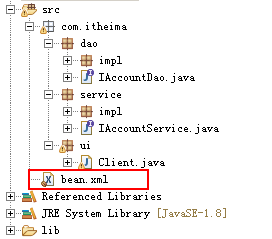第3章 使用 spring 的 IOC 解决程序耦合
3.1 案例的前期准备[会用]
本章我们使用的案例是,账户的业务层和持久层的依赖关系解决。在开始 spring 的配置之前,我们要先准备一下环境。由于我们是使用 spring 解决依赖关系,并不是真正的要做增删改查操作,所以此时我们没必要写实体类。并且我们在此处使用的是 java 工程,不是 java web 工程。
3.1.1 准备 spring 的开发包
官网:http://spring.io/
下载地址:
http://repo.springsource.org/libs-release-local/org/springframework/spring
解压:(Spring 目录结构:)
* docs :API 和开发规范.
* libs :jar 包和源码.
* schema :约束.

特别说明:
spring5 版本是用 jdk8 编写的,所以要求我们的 jdk 版本是 8 及以上。
同时 tomcat 的版本要求 8.5 及以上。
3.1.2 创建业务层接口和实现类
/**
* 账户业务层的接口
*/
public interface IAccountService {
/**
* 模拟保存账户
*/
void saveAccount();
}
public class AccountServiceImpl implements IAccountService {
private IAccountDao accountDao = new AccountDaoImpl(); //此处的依赖关系有待解决
@Override
public void saveAccount() {
accountDao.saveAccount();
}
}
3.1.3 创建持久层接口和实现类
public interface IAccountDao {
/**
* 模拟保存账户
*/
void saveAccount();
}
public class AccountDaoImpl implements IAccountDao {
@Override
public void saveAccount() {
System.out.println("保存了账户");
}
}
3.2 基于 XML 的配置(入门案例)[掌握]
3.2.1 第一步:拷贝必备的 jar 包到工程的 lib 目录中

3.2.2 第二步:在类的根路径下创建一个任意名称的 xml 文件(不能是中文)

给配置文件导入约束:
/spring-framework-5.0.2.RELEASE/docs/spring-framework-reference/html5/core.html

<?xml version="1.0" encoding="UTF-8"?>
<beans
xmlns="http://www.springframework.org/schema/beans"
xmlns:xsi="http://www.w3.org/2001/XMLSchema-instance" xsi:schemaLocation="http://www.springframework.org/schema/beans http://www.springframework.org/schema/beans/spring-beans.xsd">
</beans>
3.2.3 第三步:让 spring 管理资源,在配置文件中配置 service 和 dao
<!-- bean 标签:用于配置让 spring 创建对象,并且存入 ioc 容器之中
id 属性:对象的唯一标识。
class 属性:指定要创建对象的全限定类名
-->
<!-- 配置 service -->
<bean id="accountService" class="com.itheima.service.impl.AccountServiceImpl"></bean>
<!-- 配置 dao -->
<bean id="accountDao" class="com.itheima.dao.impl.AccountDaoImpl"></bean>
3.2.4 测试配置是否成功
public class Client {
/**
*
* @param args
*/
public static void main(String[] args) {
//1.获取核心容器对象
ApplicationContext ac = new ClassPathXmlApplicationContext("bean.xml");
//2.根据id获取Bean对象
// IAccountService as = (IAccountService)ac.getBean("accountService");
// as.saveAccount();
// IAccountService as = (IAccountService)ac.getBean("accountService2");
// as.saveAccount();
IAccountService as = (IAccountService)ac.getBean("accountService3");
as.saveAccount();
}
}
运行结果

3.3 Spring 基于 XML 的 IOC 细节[掌握]
3.3.1 spring 中工厂的类结构图


3.3.1.1 BeanFactory 和 ApplicationContext 的区别
BeanFactory 才是 Spring 容器中的顶层接口。
ApplicationContext 是它的子接口。
BeanFactory 和 ApplicationContext 的区别:
创建对象的时间点不一样。
ApplicationContext:只要一读取配置文件,默认情况下就会创建对象。
BeanFactory:什么使用什么时候创建对象。
3.3.1.2 ApplicationContext 接口的实现类
ClassPathXmlApplicationContext:
它是从类的根路径下加载配置文件 推荐使用这种
FileSystemXmlApplicationContext:
它是从磁盘路径上加载配置文件,配置文件可以在磁盘的任意位置。
AnnotationConfigApplicationContext:
当我们使用注解配置容器对象时,需要使用此类来创建 spring 容器。它用来读取注解。
3.3.2 IOC 中 bean 标签和管理对象细节
3.3.2.1 bean 标签
作用:
用于配置对象让 spring 来创建的。
默认情况下它调用的是类中的无参构造函数。如果没有无参构造函数则不能创建成功。
属性:
id:给对象在容器中提供一个唯一标识。用于获取对象。
class:指定类的全限定类名。用于反射创建对象。默认情况下调用无参构造函数。
scope:指定对象的作用范围。
* singleton :默认值,单例的.
* prototype :多例的.
* request :WEB 项目中,Spring 创建一个 Bean 的对象,将对象存入到 request 域中.
* session :WEB 项目中,Spring 创建一个 Bean 的对象,将对象存入到 session 域中.
* global session :WEB 项目中,应用在 Portlet 环境.如果没有 Portlet 环境那么
globalSession 相当于 session.
init-method:指定类中的初始化方法名称。
destroy-method:指定类中销毁方法名称。
3.3.2.2 bean 的作用范围和生命周期
单例对象:scope=“singleton”
一个应用只有一个对象的实例。它的作用范围就是整个引用。
生命周期:
对象出生:当应用加载,创建容器时,对象就被创建了。
对象活着:只要容器在,对象一直活着。
对象死亡:当应用卸载,销毁容器时,对象就被销毁了。
多例对象:scope=“prototype”
每次访问对象时,都会重新创建对象实例。
生命周期:
对象出生:当使用对象时,创建新的对象实例。
对象活着:只要对象在使用中,就一直活着。
对象死亡:当对象长时间不用时,被 java 的垃圾回收器回收了。
3.3.2.3 实例化 Bean 的三种方式
第一种方式:使用默认无参构造函数
<!--在默认情况下:
它会根据默认无参构造函数来创建类对象。如果 bean 中没有默认无参构造函数,将会创建失败。--> <bean id="accountService" class="com.itheima.service.impl.AccountServiceImpl"/>
第二种方式:spring 管理静态工厂-使用静态工厂的方法创建对象
/**
* 模拟一个静态工厂,创建业务层实现类
*/
public class StaticFactory {
public static IAccountService createAccountService() {
return new AccountServiceImpl();
}
}
<!-- 此种方式是:
使用 StaticFactory 类中的静态方法 createAccountService 创建对象, 并存入 spring 容器
id 属性: 指定 bean 的 id, 用于从容器中获取
class 属性: 指定静态工厂的全限定类名
factory - method 属性: 指定生产对象的静态方法
-->
<
bean id = "accountService"
class = "com.itheima.factory.StaticFactory"
factory - method = "createAccountService" > < /bean>
第三种方式: spring 管理实例工厂 - 使用实例工厂的方法创建对象
/**
* 模拟一个实例工厂,创建业务层实现类
* 此工厂创建对象,必须现有工厂实例对象,再调用方法
*/
public class InstanceFactory {
public IAccountService createAccountService() {
return new AccountServiceImpl();
}
}
<!-- 此种方式是:
先把工厂的创建交给 spring 来管理。
然后在使用工厂的 bean 来调用里面的方法
factory - bean 属性: 用于指定实例工厂 bean 的 id。
factory - method 属性: 用于指定实例工厂中创建对象的方法。
-->
< bean id = "instancFactory"
class = "com.itheima.factory.InstanceFactory" > < /bean> <bean id="accountService"
factory - bean = "instancFactory"
factory - method = "createAccountService" > < /bean>
3.3.3 spring 的依赖注入
3.3.3.1 依赖注入的概念
依赖注入:Dependency Injection。它是 spring 框架核心 ioc 的具体实现。
我们的程序在编写时,通过控制反转,把对象的创建交给了 spring,但是代码中不可能出现没有依赖的情况。ioc 解耦只是降低他们的依赖关系,但不会消除。例如:我们的业务层仍会调用持久层的方法。
那这种业务层和持久层的依赖关系,在使用 spring 之后,就让 spring 来维护了。简单的说,就是坐等框架把持久层对象传入业务层,而不用我们自己去获取。
3.3.3.2 构造函数注入
顾名思义,就是使用类中的构造函数,给成员变量赋值。注意,赋值的操作不是我们自己做的,而是通过配置的方式,让 spring 框架来为我们注入。具体代码如下:
public class AccountServiceImpl implements IAccountService {
//如果是经常变化的数据,并不适用于注入的方式
private String name;
private Integer age;
private Date birthday;
public AccountServiceImpl(String name,Integer age,Date birthday){
this.name = name;
this.age = age;
this.birthday = birthday;
}
public void saveAccount(){
System.out.println("service中的saveAccount方法执行了。。。"+name+","+age+","+birthday);
}
}
<!-- 使用构造函数的方式,给 service 中的属性传值
要求:
类中需要提供一个对应参数列表的构造函数。
涉及的标签:
constructor-arg
属性:
index:指定参数在构造函数参数列表的索引位置
type:指定参数在构造函数中的数据类型
name:指定参数在构造函数中的名称 用这个找给谁赋值
=======上面三个都是找给谁赋值,下面两个指的是赋什么值的==============
value:它能赋的值是基本数据类型和 String 类型
ref:它能赋的值是其他 bean 类型,也就是说,必须得是在配置文件中配置过的 bean
-->
<bean id="accountService" class="com.itheima.service.impl.AccountServiceImpl">
<constructor-arg name="name" value="张三"></constructor-arg>
<constructor-arg name="age" value="18"></constructor-arg>
<constructor-arg name="birthday" ref="now"></constructor-arg>
</bean>
<bean id="now" class="java.util.Date"></bean>
3.3.3.3 set 方法注入
顾名思义,就是在类中提供需要注入成员的 set 方法。具体代码如下:
public class AccountServiceImpl implements IAccountService {
private String name;
private Integer age;
private Date birthday;
public void setName(String name) {
this.name = name;
}
public void setAge(Integer age) {
this.age = age;
}
public void setBirthday(Date birthday) {
this.birthday = birthday;
}
@Override
public void saveAccount() {
System.out.println(name + "," + age + "," + birthday);
}
}
<!-- 通过配置文件给 bean 中的属性传值:使用 set 方法的方式
涉及的标签:
property属性:
name:找的是类中 set 方法后面的部分
ref:给属性赋值是其他 bean 类型的
value:给属性赋值是基本数据类型和 string 类型的
实际开发中,此种方式用的较多。
-->
<bean id="accountService" class="com.itheima.service.impl.AccountServiceImpl">
<property name="name" value="test"></property>
<property name="age" value="21"></property>
<property name="birthday" ref="now"></property>
</bean>
<bean id="now" class="java.util.Date"></bean>
3.3.3.4 使用 p 名称空间注入数据(本质还是调用 set 方法)
此种方式是通过在 xml 中导入 p 名称空间,使用 p:propertyName 来注入数据,它的本质仍然是调用类中的set 方法实现注入功能。
public class AccountServiceImpl4 implements IAccountService {
private String name;
private Integer age;
private Date birthday;
public void setName(String name) {
this.name = name;
}
public void setAge(Integer age) {
this.age = age;
}
public void setBirthday(Date birthday) {
this.birthday = birthday;
}
@Override
public void saveAccount() {
System.out.println(name + "," + age + "," + birthday);
}
}
配置文件代码:
<beans
xmlns="http://www.springframework.org/schema/beans"
xmlns:p="http://www.springframework.org/schema/p"
xmlns:xsi="http://www.w3.org/2001/XMLSchema-instance"
xsi:schemaLocation=" http://www.springframework.org/schema/beans
http://www.springframework.org/schema/beans/spring-beans.xsd">
<bean id="accountService"
class="com.itheima.service.impl.AccountServiceImpl4"
p:name="test" p:age="21" p:birthday-ref="now"/>
</beans>
3.3.3.5 注入集合属性
顾名思义,就是给类中的集合成员传值,它用的也是set方法注入的方式,只不过变量的数据类型都是集合。我们这里介绍注入数组,List,Set,Map,Properties。具体代码如下:
public class AccountServiceImpl implements IAccountService {
private String[] myStrs;
private List < String > myList;
private Set < String > mySet;
private Map < String, String > myMap;
private Properties myProps;
public void setMyStrs(String[] myStrs) {
this.myStrs = myStrs;
}
public void setMyList(List < String > myList) {
this.myList = myList;
}
public void setMySet(Set < String > mySet) {
this.mySet = mySet;
}
public void setMyMap(Map < String, String > myMap) {
this.myMap = myMap;
}
public void setMyProps(Properties myProps) {
this.myProps = myProps;
}
@Override
public void saveAccount() {
System.out.println(Arrays.toString(myStrs));
System.out.println(myList);
System.out.println(mySet);
System.out.println(myMap);
System.out.println(myProps);
}
}
<!-- 注入集合数据
List 结构的:
array,list,set
Map 结构的
map,entry,props,prop
-->
<bean id="accountService" class="com.itheima.service.impl.AccountServiceImpl">
<!-- 在注入集合数据时,只要结构相同,标签可以互换 -->
<!-- 给数组注入数据 -->
<property name="myStrs">
<set>
<value>AAA</value>
<value>BBB</value>
<value>CCC</value>
</set>
</property>
<!-- 注入 list 集合数据 -->
<property name="myList">
<array>
<value>AAA</value>
<value>BBB</value>
<value>CCC</value>
</array>
</property>
<!-- 注入 set 集合数据 -->
<property name="mySet">
<list>
<value>AAA</value>
<value>BBB</value>
<value>CCC</value>
</list>
</property>
<!-- 注入 Map 数据 -->
<property name="myMap">
<props>
<prop key="testA">aaa</prop>
<prop key="testB">bbb</prop>
</props>
</property>
<!-- 注入 properties 数据 -->
<property name="myProps">
<map>
<entry key="testA" value="aaa"></entry>
<entry key="testB">
<value>bbb</value>
</entry>
</map>
</property>
</bean>
